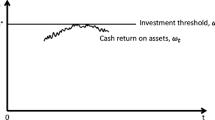Abstract
This paper develops a valuation model for a firm’s investment opportunities. Given standard market imperfections, we show that maximizing the firm’s equity value is consistent with the need to include a capital charge for an investment specific to a firm’s capital structure and in excess of the investment’s market determined risk. A reduced form credit risk perspective is taken to enable a continuous time implementation. This continuous time implementation is illustrated within the paper.
Similar content being viewed by others
References
Acharya, V., Huang, J. Subrahmanyam, M., & Sundaram, R. (2002). When does strategic debt service matter. Working Paper, New York University.
Anderson R.W., Sundaresan S.M. (1996). The Design and Valuation of Debt Contracts. Review of Financial Studies 9: 37–68
Bielecki, T.R., Rutkowski, M. (2002). Credit risk:modeling, valuation and hedging. Springer-Verlag Publications.
Brealey, R., & Myers, S. (2001). Principles of Corporate Finance (6th ed.). McGraw-Hill.
Crouhy M., Turnbull S., Wakeman L. (1999). Measuring risk-adjusted performance. Journal of Risk 2(1): 5–35
Duffie D., Jarrow R., Purnanandam A., Yang W. (2003). Market pricing of deposit insurance. Journal of Financial Services Research 24(2.3): 93–119
Fan H., Sundaresan M. (2000). Debt valuation, renegotiation, and optimal dividend policy. Review of Financial Studies 13: 1057–1099
Fischer E.O., Heinkel R., Zechner J. (1989). Dynamic capital structure choice: Theory and tests. Journal of Finance 44: 19–40
Froot K.A., Stein J. (1998). Risk management, capital budgeting, and capital structure policy for financial institutions: An integrated approach. Journal of Financial Economics 47: 55–82
Gilson S.C., Kose J., Lang L.H. (1990). Troubled debt restructuring: An empirical study of private reorganization of firms in default. Journal of Financial Economics 27: 315–353
Goldstein R., Ju N., Leland H. (2001). An EBIT-based model of dynamic capital structure. Journal of Business 74: 483–512
Jarrow R.A., Turnbull S. (1995). Pricing derivatives on financial securities subject to credit risk. Journal of Finance 50: 53–85
Jarrow, R. A., & Turnbull, S. (2000). Derivative securities (2nd ed.). SouthWestern College Publishing.
Leland H.E. (1994). Risky debt, bond covenants and optimal capital structure. Journal of Finance 49: 1213–1252
Leland H.E. (1998). Agency costs, risk management, and capital structure. Journal of Finance 49: 1213–1252
Leland H.E., Toft K. (1996). Optimal capital structure, endogenous bankruptcy, and the term structure of credit spreads. Journal of Finance 51: 987–1019
Mella-Barral P. (1999). The dynamics of default and debt reorganization. Review of Financial Studies 12: 535–578
Mella-Barral P., Perraudin W.R.M. (1997). Strategic debt service. Journal of Finance 52: 531–556
Moody’s Investors Service Report (1998). Historical default rates of corporate bond issuers, 1920–1997.
Myers S.C. (1977). Determinants of corporate borrowing. Journal of Financial Economics 5: 147–175
Myers S.C., Majluf N.S. (1984). Corporate financing and investment decisions when firms have information that investors do not have. Journal of Financial Economics 13: 187–221
Purnanandam, A. (2004). Financial distress and corporate risk management: Theory & evidence. Working Paper, Cornell University.
Robicheck A.A., Myers S.C. (1966). Problems in the theory of optimal capital structure. Journal of Financial and Quantitative Analysis 1: 1–35
Smith C., Stulz R. (1985). The determinants of firms’ hedging policies. Journal of Financial and Quantitative Analysis 28: 391–405
Zaik E., Walter J., Kelling G., James C. (1996). RAROC at Bank of America: From theory to practice. Journal of Applied Corporate Finance 9: 83–92
Author information
Authors and Affiliations
Corresponding author
Rights and permissions
About this article
Cite this article
Jarrow, R., Purnanandam, A. The valuation of a firm’s investment opportunities: a reduced form credit risk perspective. Rev Deriv Res 10, 39–58 (2007). https://doi.org/10.1007/s11147-007-9012-8
Published:
Issue Date:
DOI: https://doi.org/10.1007/s11147-007-9012-8




